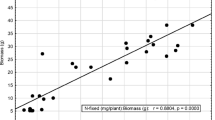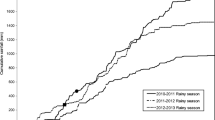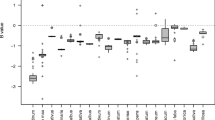Abstract
Nitrogen (N) deficiency is a major constraint to the productivity of the African smallholder farming systems. Grain, green manure and forage legumes have the potential to improve the soil N fertility of smallholder farming systems through biological N2-fixation. The N2-fixation of bean (Phaseolus vulgaris), soyabean (Glycine max), groundnut (Arachis hypogaea), Lima bean (Phaseolus lunatus), lablab (Lablab purpureus), velvet bean (Mucuna pruriens), crotalaria (Crotalaria ochroleuca), jackbean (Canavalia ensiformis), desmodium (Desmodium uncinatum), stylo (Stylosanthes guianensis) and siratro (Macroptilium atropurpureum) was assessed using the 15N natural abundance method. The experiments were conducted at three sites in western Kenya, selected on an agro-ecological zone (AEZ) gradient defined by rainfall. On a relative scale, Museno represents high potential AEZ 1, Majengo medium potential AEZ 2 and Ndori low potential AEZ 3. Rainfall in the year of experimentation was highest in AEZ 2, followed by AEZ 1 and AEZ 3. Experimental fields were classified into high, medium and low fertility classes, to assess the influence of soil fertility on N2-fixation performance. The legumes were planted with triple super phosphate (TSP) at 30 kg P ha−1, with an extra soyabean plot planted without TSP (soyabean-P), to assess response to P, and no artificial inoculation was done. Legume grain yield, shoot N accumulation, %N derived from N2-fixation, N2-fixation and net N inputs differed significantly (P<0.01) with rainfall and soil fertility. Mean grain yield ranged from 0.86 Mg ha−1, in AEZ 2, to 0.30 Mg ha−1, in AEZ 3, and from 0.78 Mg ha−1, in the high fertility field, to 0.48 Mg ha−1, in the low fertility field. Shoot N accumulation ranged from a maximum of 486 kg N ha−1 in AEZ 2, to a minimum of 10 kg N ha−1 in AEZ 3. Based on shoot biomass estimates, the species fixed 25–90% of their N requirements in AEZ 2, 23–90% in AEZ 1, and 7–77% in AEZ 3. Mean N2-fixation by green manure legumes ranged from 319 kg ha−1 (velvet bean) in AEZ 2 to 29 kg ha−1 (jackbean) in AEZ 3. For the forage legumes, mean N2-fixation ranged from 97 kg N ha−1 for desmodium in AEZ 2 to 39 kg N ha−1 for siratro in AEZ 3, while for the grain legumes, the range was from 172 kg N ha−1 for lablab in AEZ 1 to 3 kg N ha−1 for soyabean-P in AEZ 3. Lablab and groundnut showed consistently greater N2-fixation and net N inputs across agro-ecological and soil fertility gradients. The use of maize as reference crop resulted in lower N2-fixation values than when broad-leaved weed plants were used. The results demonstrate differential contributions of the green manure, forage and grain legume species to soil fertility improvement in different biophysical niches in smallholder farming systems and suggest that appropriate selection is needed to match species with the niches and farmers’ needs.



Similar content being viewed by others
References
Anderson JR (1992) Difficulties in African agricultural systems enhancement: ten hypotheses. Agri Syst 38:387–409
Anderson JM, Ingram JSI (1993) Tropical soil biology and fertility: a handbook of methods. CAB International, Wallingford, UK
Baijukya FP (2004) Adopting to changes in banana-based farming systems of northern Tanzania. PhD Dissertation, Wageningen University, Wageningen
Boddey RM, Peoples MB, Palmer B, Dart PJ (2000) Use of the 15N natural abundance technique to quantify biological nitrogen fixation by woody perennials. Nut Cycl Agroecosyst 57:235–270
Chikowo R, Mapfumo P, Nyamugafata P, Giller KE (2004) Maize productivity and mineral N dynamics following different soil fertility management practices on a depleted sandy soil in Zimbabwe. Agric Ecosyst Environ 102:109–131
Franzel S (1999) Socio-economic factors affecting the adoption potential of improved tree fallows in Africa. Agrofor Syst 7:305–321
Gathumbi SM, Cadisch G, Giller KE (2002) 15N natural abundance as a tool for assessing N2-fixation of herbaceous, shrub and tree legumes in improved fallows. Soil Boil Biochem 34:1059–1071
Giller KE (2001) Nitrogen fixation in tropical cropping systems, 2nd edn. CAB International, Wallingford, UK
Hassan RM, Murithi FM, Kamau G (1998) Determinants of fertilizer use and gap between farmer’s maize and potential yields in Kenya. In: Hassan RM (ed) Maize technology development and transfer: a GIS application for research planning in Kenya. CAB International, Wallingford, UK, pp 137–178
Hoekstra DA, Corbett J (1995) Sustainable agricultural growth for the highlands of eastern and central Africa: prospects to 2020. Prepared for the International Food Policy Research Institute (IFPRI). ICRAF, Nairobi
Hudgens RE (2000) Sustainable soil fertility in Africa: the potential for legume green manures. Soil technologies for sustainable smallholder farming systems in East Africa. Proceedings of the 15th Conference of the Soil Science Society of East Africa, Nanyuki, Kenya, pp 63–78
Jama B, Swinkles RA, Roland BJ (1997) Agronomic and economic evaluation of organic and inorganic sources of phosphorus in Western Kenya. Agron J 89:597–604
Khan DF, Peoples MB, Chalk PM, Herridge DF (2002) Quantifying below-ground nitrogen of legumes. 2. A comparison of 15N and non-isotopic methods. Plant Soil 239:277–289
McNiel AM, Zhu C, Fillery IRP (1997) Use of in situ 15N-labelling to estimate the total below-ground nitrogen of pasture legumes in intact soil-plant systems. Austr J Agric Res 48:295–304
Mureithi JG, Gachene CKK, Ojiem J (2003) The role of green manure legumes in smallholder farming systems in Kenya: The Legume Research Network Project. Trop Subtropic Agroecosyst 1:57–70
Okito A, Alves BRJ, Urquiaga S, Boddey RM (2004) Isotopic fractionation during N2 fixation by four tropical legumes. Soil Biol Biochem 36:1179–1190
Ojiem JO, de Ridder N, Vanlauwe B, Giller KE (2006) Socio-ecological niche: A conceptual framework for integration of legumes in smallholder farming systems. Int J Agric Sust 4:79–93
Ojiem JO (2006) Exploring socio-ecological niches for legumes in smallholder farming systems of Western Kenya. PhD Dissertation, Wageningen University, Wageningen
Peoples MB, Turner GL, Shah Z, Shah SH, Aslam M, Ali S, Maskey SL, Bhattraria S, Afandi F, Schwenke GD, Herridge DF (1997) Evaluation of the 15N natural abundance technique to measure N2-fixation in experimental plots and farmers’ fields. In: Rupela OP, Johansen C, Herridge DF (eds) Extending nitrogen fixation research to farmers’ field: proceedings of the international workshop on managing legume nitrogen fixation in the cropping systems of Asia. ICRISAT, Hyderabad, India, pp 57–75
Peoples MB, Faizah AW, Rerkasem B, Herridge DF (eds) (1989) Methods for evaluating nitrogen fixation by nodulated legumes in the field. ICIAR Canberra, Australia
Peoples MB, Bowman AM, Gault RR, Herridge DF, McCallum MH, McCormick KM, Norton RM, Rochester IJ, Scammell GJ, Schwenke GD (2001) Factors regulating the contributions of fixed nitrogen by pasture and crop legumes to different farming systems of eastern Australia. Plant Soil 228:29–41
Peoples MB, Boddey RM, Herridge DF (2002) Quantification of nitrogen fixation. In: Leigh GJ (ed.) Nitrogen fixation at the millennium. Elsevier Science, Amsterdam, The Netherlands, pp 357–389
Ruthenberg H (1980) Farming systems in the tropics, 3rd edn. Clarendon Press, Oxford, UK
Sanchez PA, Shepherd KD, Soule MJ, Place FM, Buresh RJ, Izac AMN, Mokwunye AU, Kwesiga FR, Nderitu CG, Woomer PL (1997) Soil fertility replenishment in Africa: an investment in natural resource capital. In: Buresh RJ, Sanchez PA, Calhoun FG (eds) Replenishing soil fertility in Africa. Soil Science Society of America, Madison, WI, USA, pp 1–46
Shearer GB, Kohl DH (1986) N2-fixation in field settings: estimations based on natural 15N abundance. Aust J Plant Phys 13:699–756
Smaling EMA, Braun AR (1996) Soil fertility research in sub-Saharan Africa: new dimensions, new challenges. Comm Soil Sc Plant Anal 27:365–386
Tarawali G, Manyong VM, Carsky RJ, Vissoh PV, Osei-Bonsu P, Galiba M (1999) Adoption of improved fallows in West Africa: lessons from mucuna and stylo case studies. Agrofor Syst 47:93–122
Tittonell P, Vanlauwe B, Leffelaar PA, Rowe EC, Giller KE (2005a) Exploring diversity in soil fertility management of smallholder farms in western Kenya. I. Heterogeneity at region and farm scale. Agric Ecosyst Environ 110:149–165
Tittonell P, Vanlauwe B, Leffelaar PA, Shepherd KD, Giller KE (2005b) Exploring diversity in soil fertility management of smallholder farms in Western Kenya II. Within-farm variability in resource allocation, nutrient flows and soil fertility status. Agric Ecosyst Environ 110:166–184
Acknowledgements
The authors thank the Rockefeller Foundation for providing the grant that enabled the implementation of this study, and the Kenya Agricultural Research Institute for availing the facilities for the study, including some of the legume seeds, which were provided by the Legume Research Network Project (LRNP). The support of all the field assistants in the three trial sites is greatly appreciated. We sincerely thank the farmers in Kakamega, Vihiga and Bondo districts in Western Kenya for their willingness to participate in the on-farm trials. Ken Giller and Nico de Ridder thank the European Union for funding through AfricaNUANCES.
Author information
Authors and Affiliations
Corresponding author
Rights and permissions
About this article
Cite this article
Ojiem, J.O., Vanlauwe, B., de Ridder, N. et al. Niche-based assessment of contributions of legumes to the nitrogen economy of Western Kenya smallholder farms. Plant Soil 292, 119–135 (2007). https://doi.org/10.1007/s11104-007-9207-7
Received:
Accepted:
Published:
Issue Date:
DOI: https://doi.org/10.1007/s11104-007-9207-7




